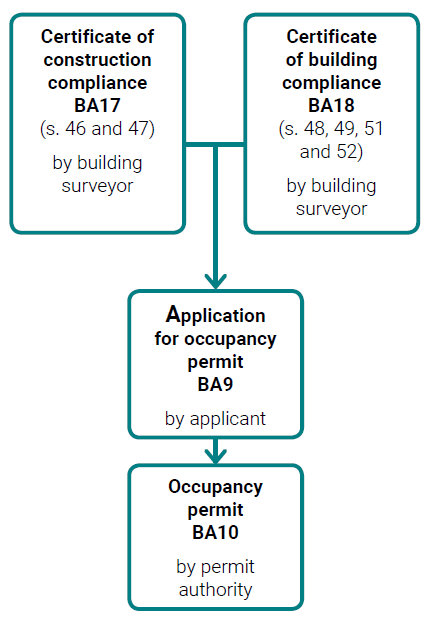Do I need an Occupancy Permit?
An Occupancy Permit is required in the following circumstances as per the Building Act 2011, section 46, 47, 48, 49, 50, 51,52 and Building Regulations 2012, regulation 4:
- Occupying a new completed building (section 46)
- Occupying an incomplete building or part of a building on a temporary basis (section 47)
- Modifying the current occupancy permit for additional use of a building on a temporary basis (section 48)
- Occupying a building or part of a building that has undergone a permanent change of use or classification (section 49)
- Strata or subdivision of a lot (section 50)
- Occupying an unauthorised building or an unauthorised part of a building (section 51)
- A replacement Occupancy Permit for a building with existing authorisation (section 52)
Existing commercial buildings and tenancies;
- For existing commercial buildings or tenancies there should be an Occupancy Permit on display in prominent location in each commercial tenancy with the correct building use and classification listed.
- Where the tenancy has been occupied prior to 2011, there should be a Certificate of Classification in place.
- If you have recently taken up a lease or are planning to, you should contact the City to find if there is an Occupancy Permit or a Certificate of Classification on file for the tenancy.
- If there is no OP in place for the building or tenancy you should apply to the City via a BA9 Occupancy Permit application once you have obtained a Certificate of Building Compliance from a private building certifier.
- A copy or details of the occupancy permit must be displayed at or near the principal entrance to the building so that it is clearly visible to occupiers and other people using the building.
Strata
If you wish to lodge a strata plan for registration or subdivide a lot in a strata scheme under the Strata Titles Act 1985, an Occupancy Permit is required via a BA9 application.
Change of classification or change of use occupancy permits
Proposing to change a building’s classification or use requires a separate Occupancy Permit in addition to an Occupancy Permit to occupy the building.
Change of use
This is where a building is proposed to be used in a different way from the use authorised by the current Occupancy Permit, but the classification remains unchanged.
Change of classification
This is where it is proposed to change the existing Building Code of Australia (BCA) classification of a building to a different classification, see below for classification descriptions.
A change of classification requires the building to comply with the current building standards relevant for the new proposed classification. This may require building work to be carried out to meet the requirements for the new classification and the submission of a Building Application.
It is recommended that a person wishing to change a building’s classification seek advice from a registered Building Surveyor; contact the City’s Building Services on 9273 6000 for a list of registered Building Surveyors or refer to the Building Commission’s website.
Building classifications
Class 1a: Single dwelling
Class 1b: Short term accommodation
Class 2: A building containing two or more sole occupancy units each being a separate dwelling
Class 3: or 4 A residential building (other than Class 1 or Class 2) located within a commercial building
Class 5: Office building including a dentist, veterinary clinic or physiotherapy rooms
Class 6: A shop or other building where goods or services are retailed directly to the public
Class 7a: Carpark building
Class 7b: A building where goods are wholesaled, such as a warehouse
Class 8: A building where a process takes place, such as a factory or workshop
Class 8a: A health-care building, such as a hospital or clinic
Class 9b: An assembly building, such as a church, childcare centre, sports hall or school
Class 9c: An aged care building
Class 10a: Non-habitable buildings such as a garage, carport or shed
Submitting a building application for an occupancy permit
If you would like to submit an application for an occupancy permit, you will need to include the following information in your application:
- A complete BA9 - Occupancy Permit application form
- Including all owner's details, construction materials and costings
- Signed by all owners
- Including applicant's contact details
- Including statement signed by applicant
BA9 application forms are available from the City's website here (link) or from the front counter of the City's Administration Centre
- A Certificate of Construction Compliance (CCC) or Certificate of Building Compliance (CBC)
This must be issued by a registered Building Surveying Practitioner and include all documentation as referenced on the Certificate of Design Compliance
Refer to the City's Fees and Charges for full fee details (link). Fee details are also available from the front counter of the City's Administration Centre.
Occupancy permit process
